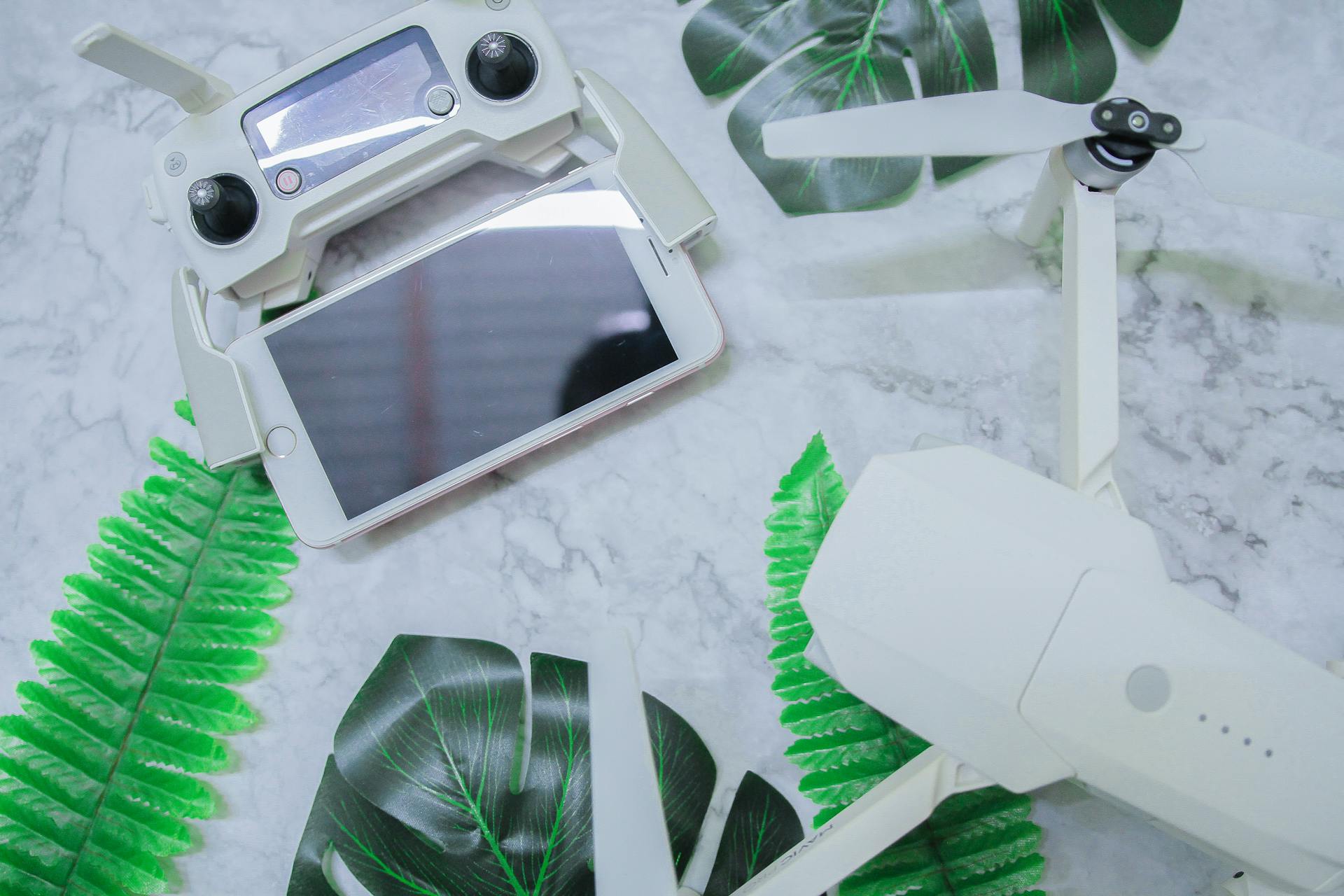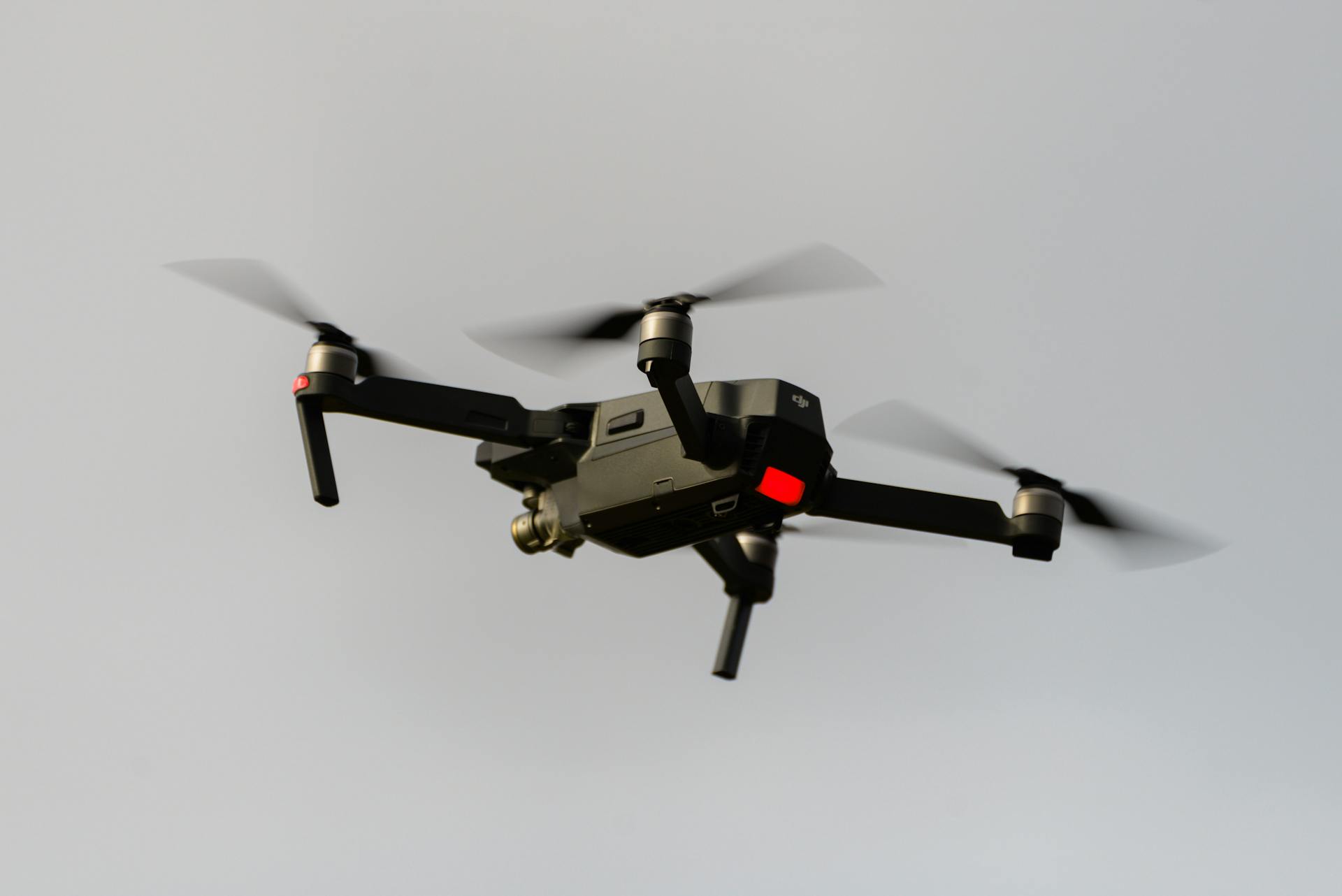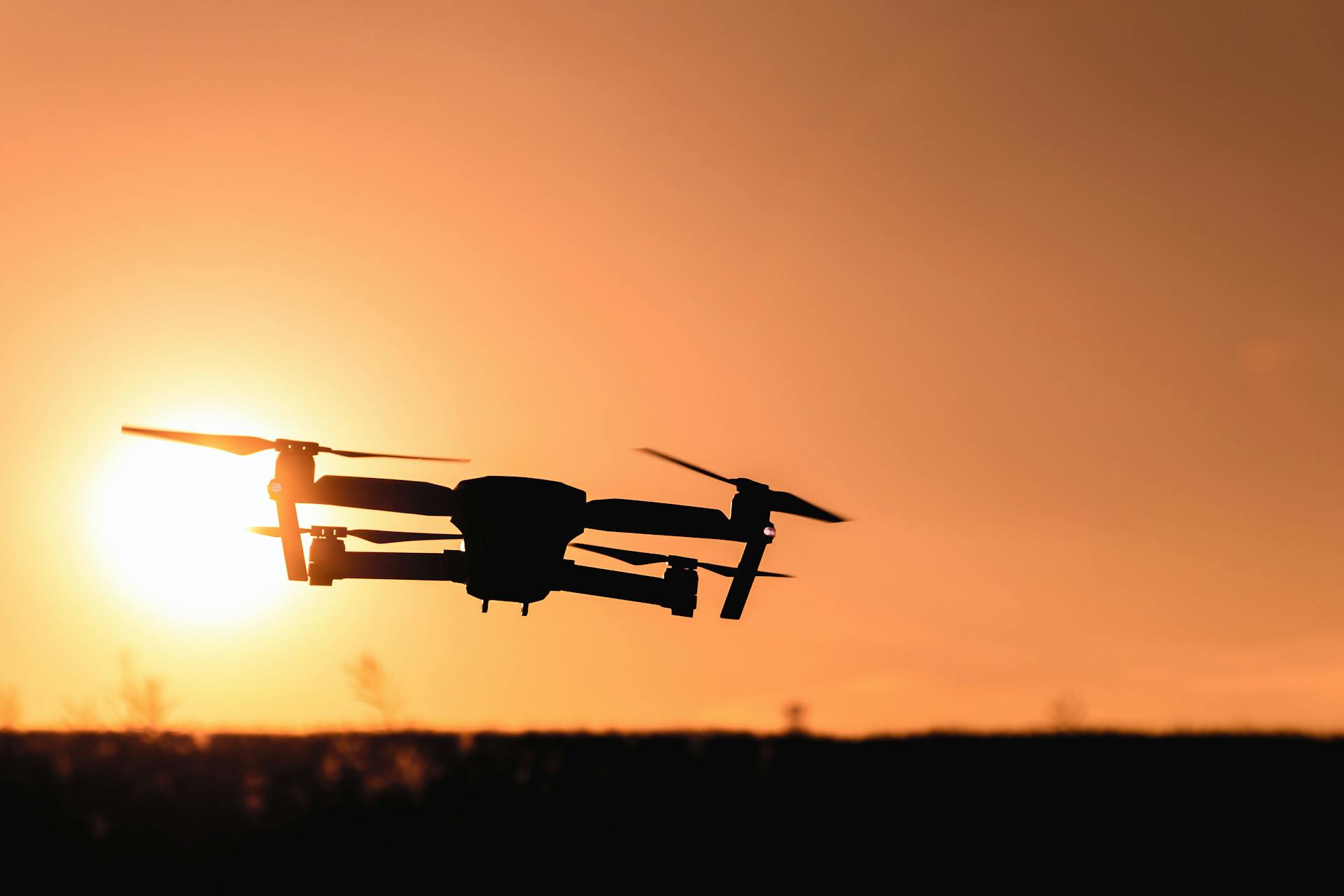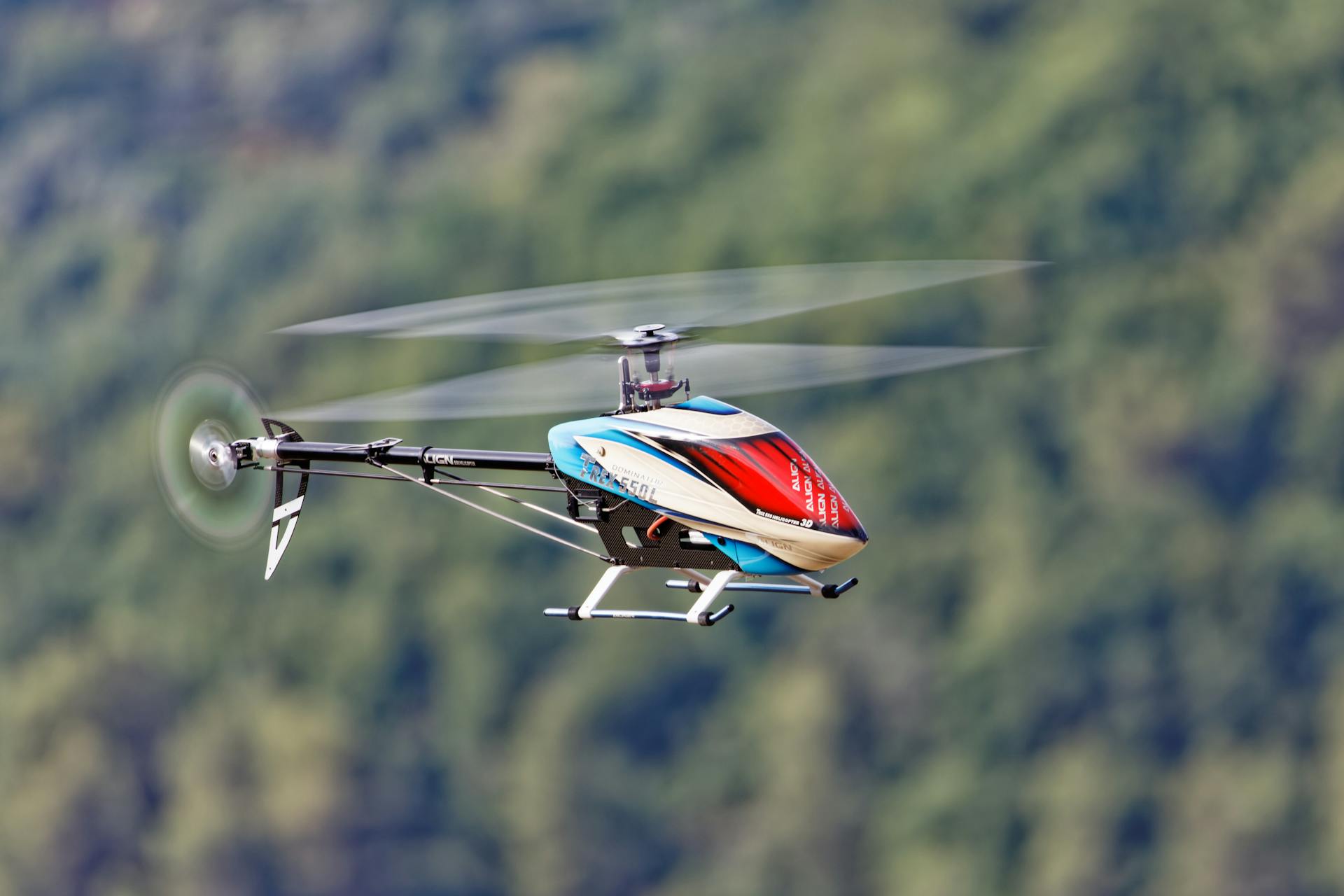
Unmanned helicopters are revolutionizing the way we think about flight and innovation. They're being used in a variety of industries, from agriculture to construction.
These autonomous aircraft are capable of carrying heavy loads, such as equipment and supplies, and can operate in areas that would be difficult or impossible for manned helicopters to reach.
One of the key benefits of unmanned helicopters is their ability to fly for long periods of time without the need for human intervention.
General Information
Unmanned helicopters are typically smaller and more maneuverable than traditional helicopters, making them ideal for tasks like surveillance and inspection.
They often have a range of up to 10 miles and can stay airborne for several hours, depending on the mission requirements.
These helicopters usually weigh between 20 and 50 pounds, making them lightweight and easy to transport.
Some unmanned helicopters can fly as fast as 50 miles per hour, while others may cruise at a slower pace of around 20 miles per hour.
These vehicles are often equipped with advanced sensors and cameras, allowing them to capture high-quality images and video in various lighting conditions.
Their ability to fly quietly and avoid detection makes them useful for tasks like search and rescue operations.
Autopilot and Control
Unmanned helicopters have made significant advancements in autopilot and control systems. The VSR700, for example, offers an optimized balance of payload capability, endurance, and operational cost, making it a reliable choice for various applications.
The VSR700's autopilot system enables it to perform autonomous free flights, as demonstrated by Airbus Helicopters in 2020. This capability is crucial for unmanned helicopters, allowing them to operate independently and efficiently.
In terms of autopilot features, the VSR700 and other unmanned helicopters like the UVH-170 offer a range of capabilities, including fully autonomous takeoff and landing, semi-autonomous control with automatic stabilization, and advanced RTL features. The UVH-170 also boasts a redundant autopilot system, ensuring safe and reliable operation.
Here are some key autopilot features found in unmanned helicopters:
- Fully Autonomous Takeoff - Landing - Cruise
- Semi-Autonomous Control with Automatic Stabilization
- Advanced RTL Features
- Redundant Autopilot System
Autopilot Features
Autopilot Features are a game-changer for unmanned helicopters. They allow for fully autonomous takeoff, landing, and cruise, making flight planning and execution a breeze.
One of the most impressive features is the ability to fly up to 100+ waypoints in real-time, making it ideal for complex missions. The autopilot system also includes advanced RTL (Return to Launch) features, ensuring a safe return to base.

The system is equipped with a redundant autopilot system, providing an added layer of safety and reliability. This means that even if one system fails, the other can take over, ensuring the mission is completed successfully.
Here are some of the key autopilot features:
- Fully Autonomous Takeoff - Landing - Cruise
- Semi-Autonomous Control with Automatic Stabilization
- Advanced RTL Features
- Real Time Mission Planning (100+ Waypoints)
- Redundant Autopilot System
These features make the autopilot system a powerful tool for unmanned helicopters, allowing for increased efficiency, safety, and reliability.
Autonomous Helicopters
Autonomous helicopters are a game-changer in the field of autopilot and control. They can perform tasks with great precision and accuracy, reducing the risk of human error and increasing efficiency.
These helicopters can fly for long periods of time, with some models capable of staying airborne for up to 20 minutes. They also have advanced sensors and cameras that allow them to detect and track targets from a distance.
One of the most impressive features of autonomous helicopters is their ability to perform complex maneuvers, such as hovering and pirouetting, with ease. This makes them ideal for tasks like surveillance and reconnaissance.
Here are some key features of autonomous helicopters:
- Fully autonomous flight capability
- Long endurance time (up to 20 minutes)
- High payload carrying capacity (up to 200 Kg)
- Advanced sensors and cameras for target detection and tracking
- Ability to perform complex maneuvers, such as hovering and pirouetting
These features make autonomous helicopters a valuable asset in a variety of applications, from military and defense to search and rescue and environmental monitoring. They can also be used for tasks like cargo transportation and aerial surveying.
The Airbus VSR700, for example, is a highly advanced autonomous helicopter that can carry multiple full-size naval sensors for extended periods. It's designed to operate from existing ships and can provide real-time image and video transmission.
Overall, autonomous helicopters are a powerful tool for a wide range of applications. Their advanced features and capabilities make them an attractive option for anyone looking to improve efficiency and accuracy in their work.
Take a look at this: List of Unmanned Aerial Vehicle Applications
Companies and Contracts
Laflamme Aero Inc. and CybAero AB are two notable companies in the unmanned helicopter industry. Laflamme Aero Inc. was established in 2006 and is headquartered in Coleraine, Quebec.
Laflamme Aero Inc. specializes in autonomous helicopters that can carry heavy loads for industrial and military use. Its latest development, the LX300, is a tandem rotor UAV-VTOL with a payload capacity of 180 kg.
CybAero AB, on the other hand, was founded in 2003 and is based in Linköping, Sweden. It produces and markets unmanned helicopters, including Vertical Takeoff and Landing Remotely Piloted Aircraft Systems (VTOL RPAS).
Here are the key facts about these two companies:
Top Global Companies
Velos Rotors Inc. is a drone technology company based in Newark, United States, with a focus on developing unmanned helicopters.
Established in 2011, Velos Rotors Inc. has been working on modifying the way aircraft are operated and built.
Its UAV platform, VelosUAV, is electric, fully redundant, and has flying times of over an hour.
VelosUAV also has a payload capacity of up to 10kg/22lbs.
Alpha Unmanned Systems SL is a key designer and producer of fuel-powered Helicopter UAVs.
The company's helicopters, the ALPHA 800 and ALPHA 900, have been employed in over eight nations.
These helicopters can take-off and land on moving vessels.
Here's a comparison of the two companies:
Leonardo Wins UK Navy Contract
Leonardo has received a contract from the UK Ministry of Defence to design and develop an uncrewed helicopter demonstrator for the Royal Navy, worth approximately £60m.
This contract marks the beginning of Phase 3 in the rotary wing uncrewed air system (RWUAS) technology demonstration programme. In Phase 1 and 2, Leonardo conducted advanced research for the RWUAS.
The new helicopter, called Proteus, aims to deliver an alternative for the Royal Navy's existing aircraft used for tracking adversary submarines. It will also provide improved surveillance and intelligence capabilities, as well as the ability to perform ship-to-ship resupply and casualty evacuation.
Velos Rotors Inc. is a drone technology company that also focuses on modifying the way aircraft are operated and built. Their UAV platform, VelosUAV, is electric and has flying times of over an hour.
Proteus is a cost-effective platform that will reduce exposure of the Royal Navy's personnel to potential threats. The aircraft is expected to provide improved surveillance and intelligence capabilities along with the ability to perform ship-to-ship resupply and casualty evacuation.
Schiebel Corporation develops sophisticated mine detection equipment and the revolutionary CAMCOPTER S-100 Unmanned Air System (UAS). The company has production facilities in Abu Dhabi (UAE) and Wiener Neustadt (Austria).
The Sikorsky MATRIX autonomy technology helicopter was created to give the Army "operational flexibility." This includes the ability to operate aircraft at all times of the day or night, with and without pilots.
Here's a list of some of the companies involved in the development of uncrewed helicopters:
- Leonardo
- Velos Rotors Inc.
- Schiebel Corporation
- CybAero AB
- Laflamme Aero Inc.
- Alpha Unmanned Systems SL
Laflamme Aero Inc. is a producer of unmanned civilian drones and copters meant to transport weighty loads for industrial and military use.
China's New Maritime Helicopters Capabilities
These unmanned helicopters measure 7.33 meters in length, 1.58 meters in width, and 2.43 meters in height.
They have a payload capacity of 75 kilograms and can operate in wind speeds of up to level 8, equivalent to no more than 74 km/h.
Their remote control range extends up to 150 kilometers, and they have a maximum endurance range of 400 kilometers.
The drones achieve a remarkable maximum flight speed of 150 km/h.
They are equipped with state-of-the-art features, including infrared thermal imaging and real-time long-distance video transmission capabilities.
These advanced helicopters also come with emergency rescue material delivery systems.
Their fuel, structure, electronics, and avionics systems have been optimized to withstand challenges like humidity, mold, and exposure to saltwater.
The unmanned aerial vehicle holds promise for ships seeking to monitor extensive maritime areas and gather vessel information efficiently.
Their design implies an affiliation with the AV500 rotary-wing vertical take-off and landing (VTOL) drone family.
These drones are designed to undertake missions even in challenging weather conditions.
Frequently Asked Questions
What is a helicopter drone called?
Multi-rotor drones are commonly referred to as helicopters, with the most popular type being quadcopters, which have four rotors
How much is the R550X helicopter?
The R550X helicopter costs between $1 million and $2 million, depending on its configuration.
Why are helicopters not built like drones?
Helicopters are not built like drones due to mechanical complexity, requiring a single rotor to perform multiple tasks. This design challenge is a key reason why drones have a distinct configuration.
Featured Images: pexels.com


